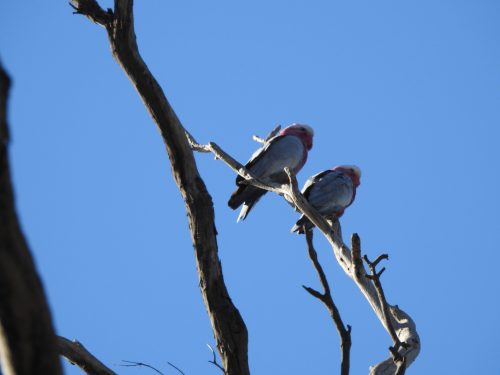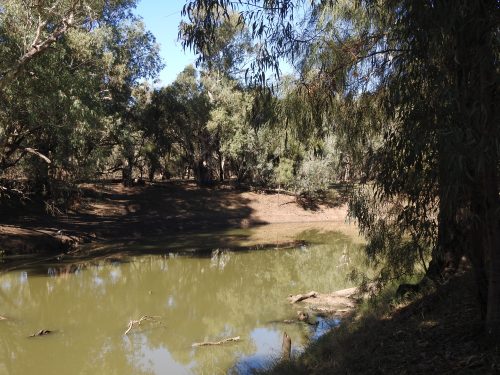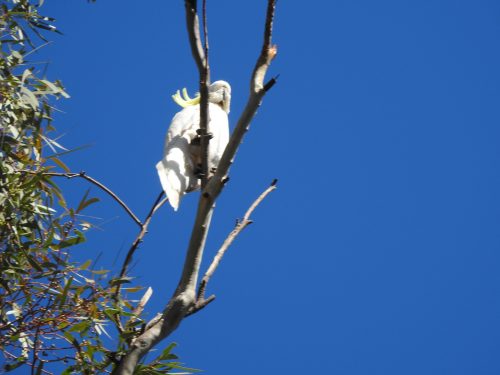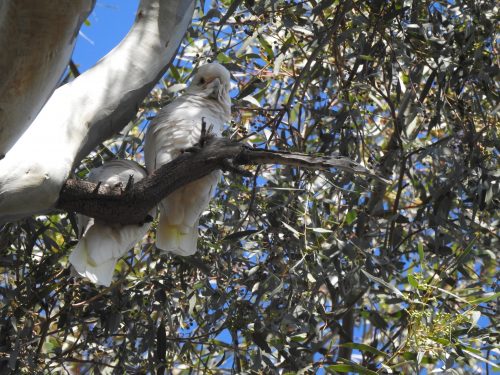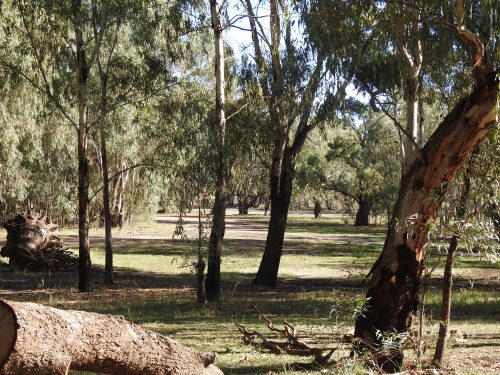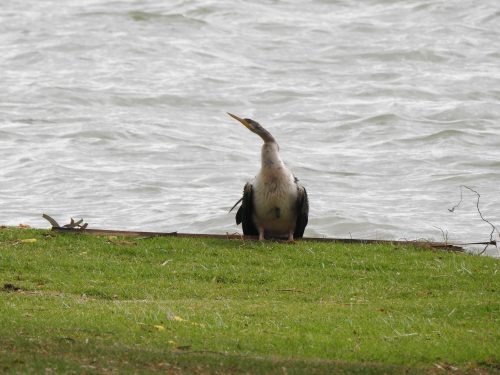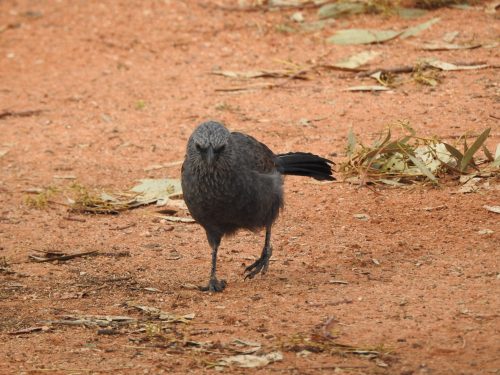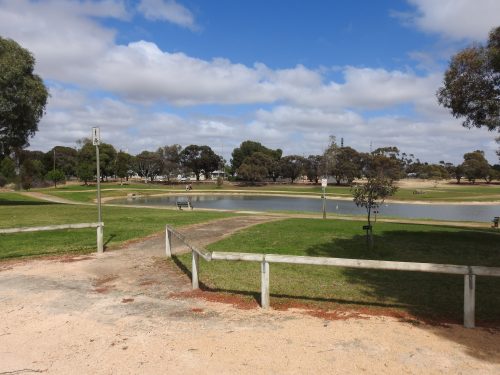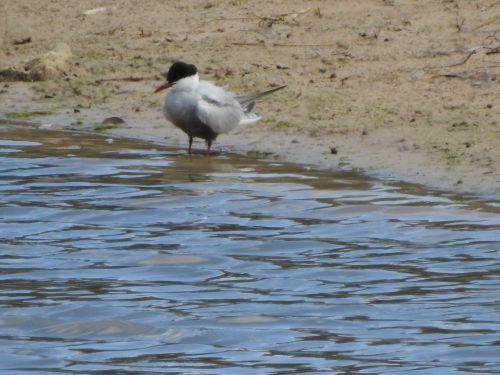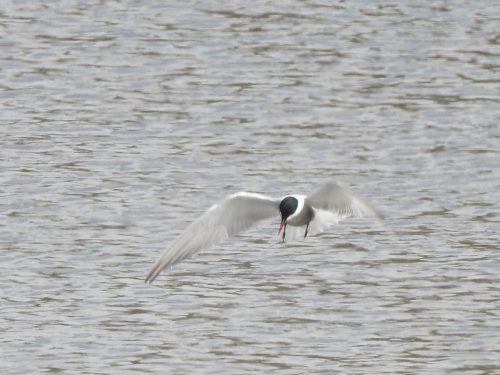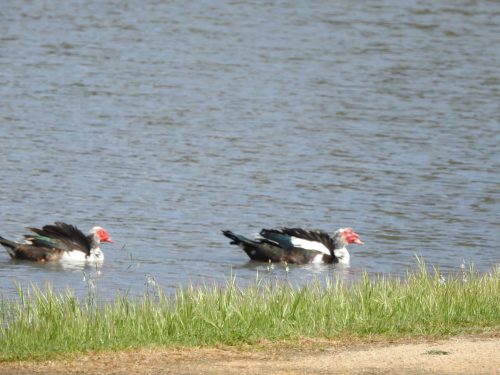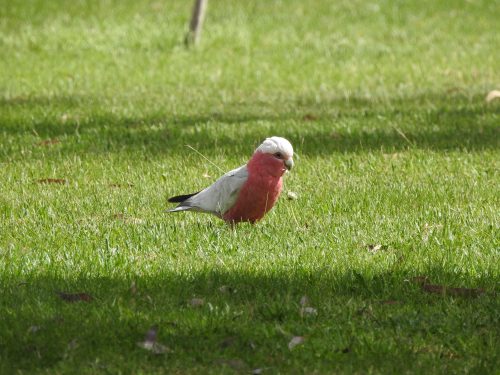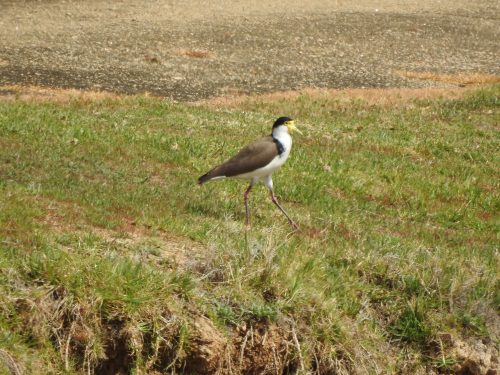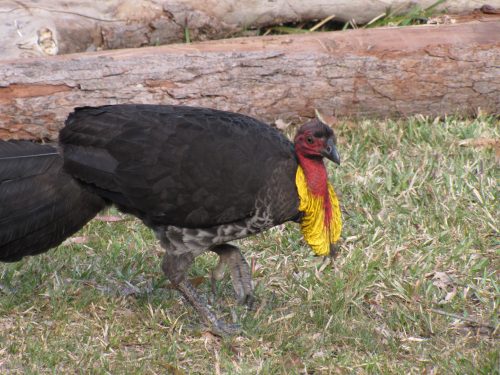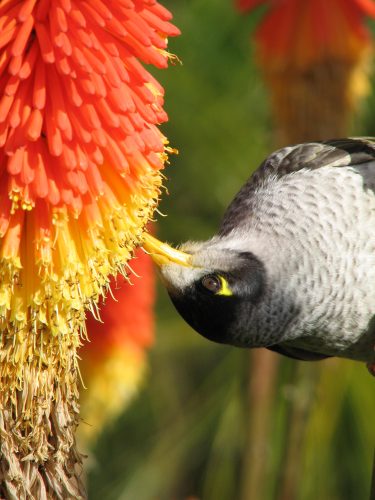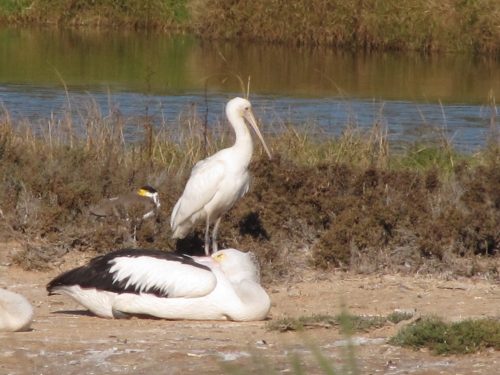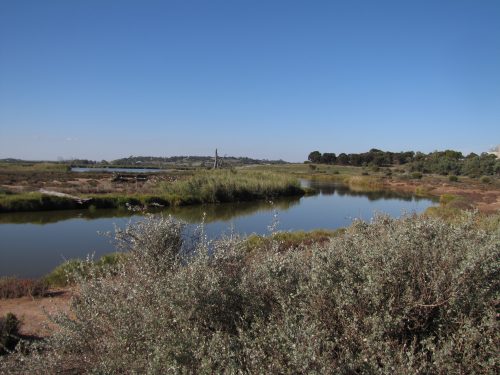Birding at Euabalong
Last month I drove from home in Murray Bridge to my son’s home in Sydney. At just over 1300 kilometres, it is a drive which can be easily done in two days. In more recent trips over there, I have chosen a variety of routes in order to see more of this wonderful land in which we live. On my most recent trip, I took four days to get there, planning to do some birding along the way.
I stayed for two nights in a cabin in the lovely Lake Cargelligo Caravan Park. This town is situated in the mid-west of New South Wales. It is, in fact, almost mid-way from anywhere in the state. The town caters for most needs of travellers but the area has suffered during the recent years of drought. By way of contrast, the area around Lake Cargelligo had received good falls of rain in the few weeks leading up to my visit. Water was lying everywhere, particularly on the sides of all roads. I hope that this good rain will help the farmers recover from their recent drought.
On the day after my arrival, I had planned to do a whole day of birding in the area. My first stop was at the small community of Euabalong which is about a half-hour drive north. The Lachlan River flows through town (see photo below) and it was certainly worth a stop to observe the local bird population.
I found a dirt track leading to the banks of the river and stopped for a while to make a list of the birds I could see and hear. The local Sulphur-crested Cockatoos (photo below) were making a terrible racket. They were screeching loudly and flying around erratically. I then spotted the cause of the upset. A Little Eagle and a Wedge-tailed Eagle were swooping low over the eucalypt trees where the cockatoos had been perched. They must have been looking for a mid-morning snack. I only saw the two eagles momentarily before they glided out of view. There was no opportunity to get a photo or two. Some Little Corellas (photo below) and Galahs (photo above) were also a part of the ruckus.
After leaving the picnic area next to the Lachlan River, I drove slowly around the small town (population less than 200) to add to my list of birds seen or heard. I could easily have added to this list by stopping elsewhere in the town, but other places were calling me to keep going.
Here is a list of birds I listed:
- Australian Raven (several)
- Crested Pigeon (2)
- Magpie-lark (2)
- Red-rumped Parrot (4)
- Galah (about 30)
- Sulphur-crested Cockatoo (100+)
- Little Eagle (1)
- Wedge-tailed Eagle (1)
- Black-backed Magpie (2)
- Peaceful Dove (1 heard)
- Apostlebird (5)
- House Sparrow (30)
- Welcome Swallow (2)
- Pied Butcherbird (1)
- Little Corella (2 photographed but there would have been more in the flying flock)
My next stop was Euabalong West, just several kilometres to the west. There I added the following species:
- Superb Parrot (1)
- White-winged Choughs (15)
- Noisy Miner (5)
- Spiny-cheeked Honeyeater (1)
- White=plumed Honeyeater (5)
Happy birding,
Trevor
Birding at Lake Cullulleraine in northern Victoria
In recent days I have been on the road again. This is my first major trip since October of 2018. I was on my way to Sydney to stay with family but I decided to take a completely different route this time. Normally I travel almost due east, travelling through Pinneroo, Ouyen, Balranald, Hay, Wagga Wagga and Goulburn. On this trip, I headed north from my home in Murray Bridge to Blanchetown where I crossed the Murray River.
I headed on east past Waikerie, Berri, Renmark and on towards Mildura in north-west Victoria. By the time I reached the small community of Lake Cullulleraine, it was time for a break and for lunch. Whenever I am travelling, I usually look for a good birding spot to add to my list of birds seen. This lake and the area nearby have always proved to be a satisfactory birding spot. In fact, many years ago my wife and I spent a lovely week in our old caravan here.
The lake is filled from the nearby Murray River and the whole river-lake complex is a rewarding birding area. Added to that is the farming area surrounding the lake which adds a different birding environment. Where the land is not used for agriculture, the remnant mallee scrublands provide birding experiences of yet another type.
As soon as I pulled up in the car park I saw a Darter drying its wings though when I took the photo above it had closed its wings for a moment. As I was having my lunch I listed all of the other birds observed around the picnic area or on the nearby lake. The following is a list of the species seen:
- Darter
- Australian Raven
- Purple Swamphen
- Australian Wood Duck (about 60)
- Black-tailed Native-hen
- Noisy Miner
- Magpie-lark
- Apostlebird (photo below)
- Willie Wagtail
- Little Corella (about 30)
- Crested Pigeon
- Australian Pelican (one only flying overhead)
- Eurasian Coot
- Australian Magpie
- Pied Butcherbird
- Masked Lapwing
- Red Rumped Parrot
It is not a long list but it was good to get started on listing the birds seen on my trip through South Australia, New South Wales and Victoria over the next few weeks. I will write about the birds I see on my journeys in the coming posts on this site.
As I prepared to leave, a small family of Apostlebirds came meandering around my car enabling me to get some good photos. They were constantly calling to each other while they scratched at the ground seeking out a few items to eat for their lunch.
Good birding,
Trevor
Back on the road again
It has been a while.
It has been far too long since I last posted an article here on this site. It has not been an easy year for me so far (read here to find out why). But now I am back and keen to post many more bird photos here, as well as relate some highlights of my travels and birding experiences.
A special birthday
Last week my family celebrated my grandson’s 10th birthday, so I just had to come over from South Australia to Sydney for the occasion. It’s a 14 hour, two-day drive so it is not a trivial undertaking. This was my first big trip by myself, so I decided to take three days and take it easy. I am pleased that I did because I saw a few birding highlights along the way. More of that in coming posts.
The birthday party was held in a park near my son’s home and it was very successful – despite the rain trying to spoil it. The invited guests were determined to have a good time, and they did not to let the rain spoil their fun. It was a huge success and the food was also great. Love party food.
Lake Roberts, Lameroo
When I left home in Murray Bridge last week, my first stop was at Lake Roberts on the edge of Lameroo, a small farming based community in the eastern part of South Australia. I stopped for a break and a cup of tea. As I was having my morning tea, I made a list of the birds seen and heard. I also grabbed my camera and took a few photos. The photo above is a general shot of the artificial lake. Behind me is a small caravan park and to my left is a picnic area with tables seats covered by a roof.
Bird list
My bird list for the twenty-minute stay is not long, nor is it exciting – except for one bird.
Galah
Australian Magpie (both white-backed and black-backed)
Welcome Swallow
Singing Honeyeater
Red Wattlebird
Willie Wagtail
Crested Pigeon
Magpie-lark
Whiskered Tern
It is the last species which grabbed my attention.
I have visited this spot on many occasions on my trips to and from Sydney. This is the first time I have recorded a Whiskered Tern in this spot, and although it is a widespread species throughout much of Australia, it was an unexpected extra on this occasion. The photos are not great, unfortunately. Many of the photos were taken at extreme zoom, and are therefore not great.
The shot above is the one occasion that the solitary bird came to rest on the small beach along the edge of the lake. For the rest of the time, it kept flying around the perimeter of the small lake, diving into the water every ten seconds or so. I am not sure what it caught to eat, but it was quite persistent in this behaviour for most of the time I watched it. One of the better photos of it flying is shown below.
(Note to self: try to master photographing birds in flight.)
Other species
I didn’t have much time to photograph all of the other species present on this visit. I have shown some of them below. One species not listed above is the Muscovy Duck. This is a feral bird found in a few places around Australia, usually near farmhouses, dams and artificial lakes and ponds. It is native to Mexico, Central and South America. Feral populations exist in many countries, mainly as a result of releases by people or escapes from farms and gardens.
Get away, Turkey
Over recent weeks we have been staying with family in Sydney. During our four week stay, we have observed Australian Brush Turkeys on many occasions. One actually walked past their house on the footpath in Artarmon. Whenever we have visited various parks and gardens around this area, we have seen one or more turkeys. It is something we do not get to see where we live in South Australia, so it is something of a treat and special to us.
Last weekend I was driving my family to Little Athletics. I don’t normally get to see my grandson compete, so it was a special occasion. Just as we were about to get to the athletics track, I had to slow down for a turkey in the middle of the street. It was casually walking across the road, oblivious to the traffic which was thankfully quite light – our car was the only one at that point.
As the turkey strolled across the street, I was amused to see three Noisy Miners harassing it all the way. They obviously did not want the turkey in their territory. Perhaps they were nesting and were being overprotective of their eggs or young. The turkey was no threat to either eggs or young, so I don’t know why they were so annoyed by the turkey’s presence. Perhaps they were just being annoying for the sake of it.
Whatever the reason, it made me laugh to see the turkey ducking and weaving to get away from the miners’ pecks on its back. I didn’t get a photo because I was driving, and my camera was not within easy reach, anyway. I have included a photo above of a turkey taken in the nearby Lane Cove National Park a few days earlier. On that occasion, the turkey in the photo was harassing us as it attempted to scrounge some food from our picnic table. I’ll write about that in another post soon. The photo of a Noisy Miner below was taken some time ago in the Adelaide Botanic Gardens.
Other birds
For the rest of the afternoon, I was more interested in watching my grandson competing than in the local birdlife. There were plenty more Noisy Miners and Rainbow Lorikeets, several Australian Black-backed Magpies, a few Australian Ravens, one Magpie Lark and several Laughing Kookaburras. Three Crested Pigeons tried several times to settle on the grass to feed, only to be disturbed by the children running around the track, or moving across the oval to their next event. There was no sign of the Channel-billed Cuckoo I observed at the same location a week earlier.
Readers:
I would love to read about any funny incidents you have seen involving birds, I would be very happy for you to leave comments.
Good birding,
Trevor
Rocky Gully Wetlands, Murray Bridge
Earlier this year I spent a whole afternoon birding at various sites around my hometown of Murray Bridge here in South Australia. One of those sites was the Rocky Gully Wetlands on Mannum Road. I frequently drive past this wetland area, glancing at the lagoons as I drive, but not stopping. I need to change that and linger for a few minutes and take a much more careful note of the birds present. That action is probably safer than birding while driving, anyway.
Bush birds
On this occasion, there were plenty of birds present. Around the lagoons, there were quite a few smaller bush birds in the trees and shrubs that have been planted in the area. This included Red Wattlebirds, White-plumed Honeyeaters, Singing Honeyeaters and New Holland Honeyeaters. I heard a Grey Shrike-thrush calling and several times I heard the resident Superb Fairy-wrens twittering their soft calls to each other. Several Crested Pigeons were present and three Galahs were the only parrots seen at this location. Normally, I would expect to see Little Corellas and several kinds of Lorikeets here. They were absent on this visit.
Waterbirds
On the water of the lagoons or on the several islands I could see quite a few Grey Teal and Chestnut Teal, but interestingly, no Pacific Black Ducks which are very common in this area. A small number of Black-winged Stilts, Eurasian Coots and a solitary Purple Swamphen were seen, along with four Australian Pelicans, a White-necked Heron and a Great Egret. The egret was slowly wading in the shallows looking for a feed. It is a pity I didn’t get a good photo of this bird and its reflections in the water.
Of particular interest were the small group of both Royal and Yellow-billed Spoonbills. I always love seeing these species wherever I go birding. The most interesting sighting, however, was the count of twelve Australasian Darters. While this number is common in many parts of Australia, I have never seen so many in one spot in this region. Probably the most numerous species present were the Silver Gulls, with between 30 and 40 birds around the wetlands.
Further reading:
For each of the species mentioned in this post, I have written one or more articles about them on this site. To read them, go to the search facility in the top right-hand corner and type in the name of the species.
Newsletter:
I also invite you to subscribe to my occasional newsletter (see below the comments).
Good birding,
Trevor
